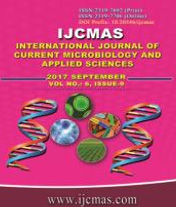


 National Academy of Agricultural Sciences (NAAS)
National Academy of Agricultural Sciences (NAAS)

|
PRINT ISSN : 2319-7692
Online ISSN : 2319-7706 Issues : 12 per year Publisher : Excellent Publishers Email : editorijcmas@gmail.com / submit@ijcmas.com Editor-in-chief: Dr.M.Prakash Index Copernicus ICV 2018: 95.39 NAAS RATING 2020: 5.38 |
Six fungicides viz., captan 50 WP, copper oxychloride 50 WP, dodine 65 WP, mancozeb75 WP, propineb70 WP and zineb 80 WP were evaluated against rice sheath blight (Thanatephorus cucumeris). The in-vitro evaluation of these fungicides through poisoned food technique at five different concentrations viz., 50, 100, 200, 500 and 1000 µg a.i ml-1 indicated that mancozeb proved the most effective exhibiting mean mycelial growth inhibition of 95.26 per cent followed by captan and dodine with 93.80 and 93.66 per cent, respectively. Copper oxychloride proved least effective and resulted in only 44.08 per cent mean inhibition of mycelial growth. Maximum mean inhibition of sclerotial germination was exhibited by mancozeb (51.33%) followed by captan (45.06%) while dodine and propineb caused only 41.20 and 33.86 per cent mean inhibition of sclerotial germination, respectively. Copper oxychloride proved least effective causing 2.44 per cent mean inhibition of sclerotial germination only. In field evaluation, three foliar sprays of each fungicide at their recommended concentrations, separately applied at tillering, booting and post flowering stages of rice cultivar K-448 (Jhelum), revealed that mancozeb75 WP was most efficacious and reduced the mean disease incidence and disease intensity from 40.00 and 19.15 per cent in unsprayed check to 18.50 and 6.98 per cent, respectively, and increased the grain yield from 5.10 t ha-1 in unsprayed check to 6.25 t ha-1, providing an increase of 22.54 per cent over control. Captan 50 WP was next in efficiency and resulted in mean disease incidence of 21.50 and mean disease intensity of 8.24 per cent and a mean grain yield of 6.05 t ha-1, providing an increase in grain yield of 18.62 per cent. The other fungicides in order of their decreasing efficacies were dodine 65 WP, propanib 70 WP and zineb 80 WP which resulted in mean disease incidence of 24.25, 25.25 and 27.00 per cent, disease intensity of 8.55, 9.26 and 9.72 per cent and a mean grain yield of 5.95, 5.80 and 5.65 t ha-1 with an increase in grain of 16.66, 13.72 and 10.78 per cent, respectively. Copper oxychloride 50 WP proved least efficacious, exhibiting disease mean incidence of 32.00 per cent and mean disease intensity of 11.99 per cent and a grain yield of 5.45 t ha-1, with lowest increase in grain yield of 6.86 per cent only.
 |
 |
 |
 |
 |